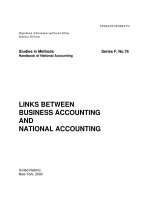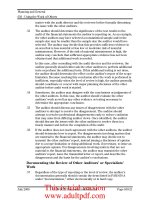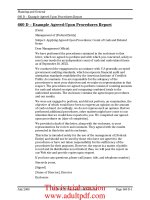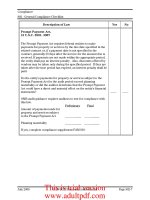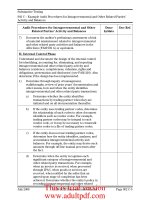business accounting volume 2 constructive accounting
Bạn đang xem bản rút gọn của tài liệu. Xem và tải ngay bản đầy đủ của tài liệu tại đây (22.6 MB, 531 trang )
BUSINESS
ACCOUNTING
Harold
Dudley
Greeley,
C.P.A.,
Editor
Volume I
—
Theory of
Accounts
By
Harold Dudley
Greeley
II
—
Constructive Accounting
By
George E.
Bennett
III
—
Cost Accounting
By
DeWitt Carl Eggleston
IV
—
Advanced and
Analytical Accounting
By Henry
C.
Cox
V
—
Illustrative
Accounting Problems
By Charles F. Rittenhouse and
Harold Dudley Greeley
Business Accounting
VOLUME 11
CONSTRUCTIVE
ACCOUNTING
A
Manual
of
System
Building
By
GEORGE E. BENNETT, A.B.,
LL.M.
Certified Public Accountant ; Professor and
Director of
the Department of Accounting, Syracuse
University
Second
Printing
NEW YORK
THE RONALD PRESS COMPANY
1921
400G7
Copyright,
1920,
by
The Ronald
Press Company
All Rights Reserved
Bns.
Admin,
library
HF
EDITORIAL
PREFACE
r,
V. 2
Ten
years ago almost any contribution
to
the
liter-
ature of accountancy would have
been
welcomed.
Today, however, with
the increasing
number of
excel-
lent publications,
it is
incumbent
upon
one who puts
forth a new accounting work
to
justify
his action.
Much
more is
it
necessary
to explain
the publication
of a set of accounting books. Hence
it is desirable to
state at the outset the
purpose
of
"Business Account-
ing"
and
to outline its
scope
and
general
methods
of
presentation.
While many
books have been
published
on
account-
ing topics,
in
almost every
case they
are unrelated
vol-
umes.
In some
few
instances,
a
volume
on
accounting
has logically followed another by
the
same author, but
with
these
few
exceptions
every
one
published
has
been
written without connection with,
or adjustment to,
any
of
those
already existing. Under these conditions, the
student
of accounting,
to
get
any connected and logical
knowledge of
his subject, must find
one of
his
books
here, another there,
a
third somewhere else, and bridge
over the gaps
between them
as best he may.
The proc-
ess is
difficult,
and the accounting
knowledge
he
obtains
is
not always
well
co-ordinated and
logically developed.
The
volumes of "Business Accounting"
are
intended
to meet this
situation They cannot, it is true,
provide
a
course
of
study
in
the sense
that prescribed readings
are recommended,
written answers to questions required,
and personal instruction
given. Neither
do
they
con-
iii
iv EDITORIAL
PREFACE
stitute
an
encyclopaedia of
unconnected and
isolated
articles. Rather
are they an
attempt
to
present
in
simple,
non-technical
language the
basic principles
of
account-keeping
and
their application to
various lines
of business, together
with general
directions for prepar-
ing,
analyzing, and
interpreting
accounting statements.
One
who starts
at
the
beginning
of Volume
I and
works faithfully through to the end
of Volume IV, and
then
solves the problems and
examines
the
solutions of
Volume
V,
should acquire some real
understanding
of
the theory and practice
of accounts—
a
knowledge
that,
supplemented
by
experience, should enable
him success-
fully
to stand the test
of practical work in any ordinary
business office and
furnish
a
foundation for going as
much further
into the
study
of
accountancy
as he
may
desire.
It may be noted
in
passing that the volumes
of
"Business Accounting"
have
been
indexed in such
a
way
as to provide
many
of the
features of
an encyclo-
paedia, so that
the person desiring
the practice
on a
particular
point or
accounting
ideas
of
suggestive value
in particular
lines of industry will
be
able
to use
the set
to advantage.
Taking
up the volumes
of the
set in order—
Volume
I presents
the fundamental principles
of account-keep-
ing and statement preparation.
Upon
these basic
prin-
ciples
all systems
of
account
are built. Volume
II
ex-
plains
the principles governing the
development
of
the
simple accounting
procedures
described
in
Volume
I
to
meet the
needs
of more complicated
and
more
exten-
sive
systems of financial accounting.
Volume
III
ex-
plains
in
much
the same way
how
the basic
principles
EDITORIAL
PREFACE
v
have been
applied
to factory or
cost
accounting.
Hav-
ing
thus traced
the
fundamental
principles into more
elaborate
financial
and cost
accounting
procedures.
Vol-
ume
IV
treats accounting
principles
and practices
which are
more
advanced
than
the basic
ones
described
in
Volume
I.
These advanced principles are
in
most
cases
subject to
differences of
opinion,
as to
their
nature
or
application,
among persons qualified to deal
with
them, and it is
for this reason that their
discussion
is
confined to
Volume
IV.
Supplementing
the illustra-
tions
of
accounting
principles and
statement prepara-
tion,
there
follows in
Volume IV
a
practical discussion
of
the
methods
of verifying
accounts and
statements and
of their
interpretation and
analysis.
The set
closes with
Volume
V, which gives
a
num-
ber
of
problems
of
a
practical
nature, together with
their
solutions.
The working of these
problems will
not
only
clarify
the
reader's ideas
but in many cases
will
provide
models upon
which he can base
accounting
procedures and build
statements to
meet concrete situa-
tions
arising
in his own work.
The readers to
whom this
set
will appeal most
strongly
may be divided roughly into
two
classes.
There
will be, on the one
hand, business and
professional
men,
bankers,
office managers,
and
other
executives who
feel
the need of
understanding
in a
general
way
the methods
of modem
account-keeping and
statement
preparation.
There can hardly be excuse
nowadays for
them to
con-
sider bookkeeping
methods
and
accounting
statements
as
too
complicated
to
understand
or
of such slight
im-
portance
as
to
merit
no
attention. They
need
a
grasp
of
the
subject
so that they
may judge
for
themselves
vi
EDITORIAL PREFACE
whether
bookkeepers and other
persons
who
keep
ac-
counts
for them
and
render
statements
to
them are
giving
information
which
is
accurate,
adequate, and
presented
in the
most intelligible form.
The entire
tendency of
modern
business and civic life
is toward
more exact
accounting, of which the accounting
re-
quirements
of
the present
income tax
legislation are but
one
indication. Any person
having
substantial
inter-
ests at
stake should be able to appraise
intelligently
the stewardship
of those to
whom
his interests are
in-
trusted and
the volumes of "Business Accounting"
will
give
him
the
technical information this
demands.
The other class of persons
to whom
"Business Ac-
counting" will
appeal
is
composed of those
whose duty
it
is to keep accounts
and to prepare statements.
They
should find in this set an
inspiration
and an aid
to more
intensive
study,
which
in
turn
will result in
improved
accounting ability and
an
enhanced wage.
The careful
and intelligent
use of
these
books will lead
beyond ques-
tion to increased power of
service to
employer and
com-
munity.
Haeold
Dudley
Greeley,
Editor,
Business Accounting
Set.
New
York
City,
April
1,
1920
PREFACE
Within the
past
few years,
many
books
have been
written on the
principles
of
accounting.
But,
so
far as
the
author
is
aware, "Constructive Accounting"
is
the
first
attempt to present the principles of accounting
con-
struction as
distinct from those
of purely
business
op-
eration. The work is intended
to assist in
the designing
of appropriate
business
records
and statements for
a
new enterprise,
or for
one already in
operation that re-
quires
certain features of its accounting
system
to be
replaced, modified,
or
improved.
The
really
qualified
bookkeeper
or
accountant
should
be capable
not
only
of performing
the routine
tasks of
bookkeeping,
but also
of undertaking
work
of
higher grade, requiring
initiative
and
exact
profes-
sional
skill. He should
know
what defects,
if
any,
are
to be
found
in
the
system
under his
control
and
be
able
to correct these
so
as
to
secure for
the enterprise
a
com-
plete, understandable, and readily
available
record
of
its transactions with
others, the cost of
securing
and
handling
the commodities in which
it deals,
its
loss
or
gain
in
past periods, and its present
trend.
He should
be
able
to
build up
a system that
will,
at
a
minimum
of
effort,
do
all this
and
at
the same time secure
a
maxi-
mum
of
protection
against error, omission,
or
fraud.
It
is in
preparing the practitioner for such
work
that
the
author trusts the
present volume
will find
a definite
place.
In
all accounting systems the underlying
principles
are, of course,
the
same, their application or
combina-
vii
yiii
PREFACE
tion varying
with the requirements
of
the
particular
business. Recognizing this
fact, the method
of the
present volume is to analyze
the records and
practices
of ordinary bookkeeping
and accounting and show
how
these may be combined
and
utilized
to
form
a
system
adapted
to meet special requirements. In doing this,
the various forms
of
ordinary accounting records are
examined and their special functions discussed
so
that
systems
built
up from
them
will meet such requirements.
It has
not
been attempted to present in this book
systems complete
in
detail. These must vary
according
to
the circumstances of
each business. But
the outlines
presented
should give
a basis
for development.
The
points of difficulty
most
frequently met with
in trading
operations and the general
conduct
of modern business
are the points
of discussion in the
systems
considered.
In passing
from one
to
another of these, the aim
has
been to
work from simpler systems
to
those
of
more
complexity.
Accountants will naturally differ
as
to
particular
methods to be
employed
in
each
case. The
author
feels,
however,
that
the plans and methods
here
presented
—
the
result
of
experience, investigation,
and
consultation
with
professional
associates—
will, taken as
a whole, be
found
helpful,
practical, and
in
accord
with
best
modern
practice.
Criticisms, comments,
and suggestions
from
those
who use the volume will be most
welcome.
George
E. Bennett
New
York
City,
April
1,
1920
CONTENTS
Part I—
Principles
and Practice
Chapter Page
I Introductory
8
1.
Accounting Theory
and Practice
2.
Place of Accounting in
Organization
3.
Necessity for Proper
Accounting
System
4.
Branches
of Accounting
6. Operative and Inspective
Accounting
6. Function
of Constructive Accounting
II
The Working Organization
9
1. Scope of
Working Organization
2. Fundamental Divisions of Business
Operation
3. Subsidiary
Departments
4. Types
of
Business
Control
6. Partnership Organization
6. Partnership Accounting
7.
Corporate Control
8.
Corporation Accounting
9.
General Lines
of
Organization
10. The Organization Chart
III
Development of
Records
25
1.
Accounting Records
2. The Simple
Triad
of Records
3. The
Development
of Books of Original Record
4.
Development of Ledger Records
5.
Arrangement
of
Entries
IV The
Survey
32
1.
Preliminary Considerations
2. Object of the
Survey
3.
Character of the Business
4.
Trading and Manufacturing
Records Compared
5. Books in
Use
6.
Accounts in
Use
7.
General Rules for
Dealing with Specific
Cases
8.
Working Papers
V
Planning
an
Accounting System 42
1. Outlining a Plan
2. Organization Plan
ix
t
CONTENTS
Chapter
Paob
3.
Co-operation of Officials and Employees
4. Chart
of Accounts
6. The
Ledgers
6. The
Records
of
Original Entry
7.
Subsidiary and
Auxiliary
Forms
8.
Time for Installation
9.
Rules
10.
Supervision
VI
Forms
and
Records
62
1. Forms a
Matter
of
Convenience
2. The
Form in Its
Relation
to System
3.
Completeness
of
Routine
4.
Uniformity
5.
The
Amount
of
Detail on
a
Form
6.
Questions to be Answered when Ruling
a Form
7.
Rulings and Columns
VII
Loose-Leaf and Bound Records
60
1. Increase
in
Use of Loose-I^eaf
Records
2.
Advantages of Bound
Books
3. Disadvantages of Bound Books
4. Advantages of
Loose-Leaf
Records
6. Disadvantages
of
Loose-Leaf
Records
6. Precautions in Installing
Loose-Leaf Records
7. Cards
VIII Purchase Department
Organization
69
1.
Importance
of Subject
2. Purchasing and Cost
of Goods
Sold
3. Results
of
Unscientific
Purchasing
4. Small versus
Large Business
5.
Activities of the
Purchase Department
IX
Purchase
Department
Routine
76
1. Preparation for
Purchasing
2.
Purchase System
Requirements
3. The Elements
of a Purchase
4. Purchase
Specifications
5.
The Purchase
Requisition
6.
Accuracy
of Content
of
Requisition
7. Form
and
Number of
Copies
of
Purchase
Requisition
Required
8. Placing
the Order
9. The
Purchase
Order
10.
Purchase Order
Register
11.
Order
Follow-Up
12.
Shipments
on Order
CONTENTS xi
Chapter
Page
X Purchase
Department
Routine
(Continued)
. 98
1.
Necessity
for
Accurate "Work
2.
Invoice
Register
3.
Cash Discount
4.
Invoice Checking
and Approval
6. Procedure
for Recording
Invoices
XI Purchase
Records
104
1.
Recording
Purchases
2. The Three-Column
Journal
3.
The Purchase Book
4. Purchase
Book Posting
5.
The Invoice
Book
6. Columnar
Purchase
and Expense
Journal
7. When
Columnar Purchase
and
Expense
Journal
Is Undesirable
8. Purchase
Journal vs.
Voucher
Register
9. The Voucher
System
10. Statement
Vouchers
11.
Handling Invoices
Without
a
Record
of
Creditors
12. Cash
Purchases
XII Purchase
Records
(Continued)
128
1. Monthly
Summary
of Purchases
2. Merchandise
Returned
]\Iemorandum
3. Return and
Allowance
Register
4. Return
and Allowance
Register
Analysis
6. Debit
Memorandum
6. Credit
Memorandum
7. Consignments
Inward
8. Conclusion
XIII Stores
Systems
180
1. Stores
Organization
2. Stores
Defined
3.
Uniformity
in
the
Stores
Department
4. Minimum
Stores
6.
Maximum
Stores
6.
The
Stores Problem
7. Receipt
of Materials
8. Stores
Accountability
9. "Purchased"
Division
of Stores Ledger
10.
"Sold" Division
of
Stores Ledger
11. "Balance"
Division
of Stores
Ledger
12.
Abstract
of Stores Ledger
13. Gross
Profit
and Cost
of Sales
14. Inventory
at Both
Cost and Selling
Prices
ii
CONTENTS
Chapter
Page
XIV
Sales
Department
Organization
146
1.
Profitable
Selling
2.
Functions of
the Sales
Department
8.
Sales
Department
Organization
4. The
Retail
Organization
6,
The Small
RetaU Store
6.
The Jobbing
Organization
7. The Mail-Order
Business
8. The Combination of the
Retail and the Jobbing
Organization
9. The
Advertising Department
XV Sales Order
Routine
166
1. Importance of Careful
Handling
2.
Recording
the Sales
Order on Uniform
Blank
3. Sales
Register
4. The Credit Department
6. Order Interpretation
6.
Duplicate Copies of Order
7.
Accounting Department
Routine
XVI
Sales Records 162
1. Recording Sales
2.
Necessity for Sales Records
3. Records
of Sales
on
Credit
4. The
Three-Column
Journal
6.
The
Sales Book
6. The Impression
Book
7.
Bound
Book of Invoices
8. Duplicate Loose-Leaf
Invoices
9. The Billing
Machine
10. The
Billing
Machine
in
a
Department
Store
11. Sales Book
of a Wholesale Concern
12. Alternate
Sales System
for a Small
Concern
13.
Sales Recapitulation
14.
A
Mechanical
Account
System
15. Returned
Sales
16.
Duplicate
Receipts
for Cash Sales
17.
The Cash
Register
18. Sales
on Consignment
19.
Sales Book
for Consignee
20.
Sales on Approval
21.
C. O. D. Sales
22.
Containers
23.
Instalment
Sales
24.
Coupon
Books
CONTENTS
Chapter
XVII General
Cash Records
Page
189
1.
The
Separate
Cash
Record
2. Reason for Distinct
Records
3. Development
of
Cash Records
4. The Essentials
of a
Cash System
6.
The
Simple
Cash
Book
6. The Cash Book
Not
a Ledger
Account
7. Cash Book Entries
8. Cash Book
Columnarization
9. Recording
Cash Discount
10. Controlling
Accounts with
Debtors
and Creditors
XVIII General
Cash Records
(Continued)
201
1. General
Cash Book for
a Mercantile
Concern
2.
Cash Sales
3. Charitable
Institution
Cash
Book
4. The Cash Receipts
Register
5. The Check Register
6.
Cash Recapitulation
Record
7.
The
Voucher Check
8. Opening
the Mail
9.
The Mechanical
Cash Register
XIX Petty
Cash
Records
217
1. The Imprest
System
2. The Fixed
Fund and
Account
for Petty
Cash
3. The Petty Cash
Book as
a Posting
Medium
4. Petty
Cash Vouchers
6.
Handling Many
Items
of a Similar
Kind
XX Miscellaneous
Cash
Records
222
1.
The Cash Journal
2. Cash Memorandum
for
Cash Returned
3. Cashier's
Cash Distribution
4.
Daily
Cash Report
6. The
Private Cash Book
XXI The Journal
231
1. Books of Original Entry
2.
Entries in the General
journal
3.
Opening and
Closing
Entries
4. Journal Vouchers
5.
The Two-Column
Journal
6.
Three-Column
Journal
7. Four-Column
Journal
8. Six-Column
Journal
9. "Left
and Right"
Journal
10.
Cut Sheet Journal
CONTENTS
Chapter
XXII
Thk Ledger
Page
247
1.
General Use
2.
Records of Original Entry
3.
Records of
Summarization
4.
Standard
Ledger Form
6.
Development of
Ledger Ruling
6.
Ledger Form
with Debits and Credits in Center
7. The
Journal-Ruled
Ledger Form
8.
Tabular
Ledgers
9. Bank
Depositors
Ledger
10.
Club
Members Ledger
11.
Rent Register
12. I^edger Account
with Wide Explanation Column
13.
Ledger Form with
Balance Column in Center
14. Standard Ledger Form
with Balance Column
at
Right
15. Special Form of Sales
Ledger
16.
Standard Ledger Form with Double Columns
17. The Columnar
Ledger
18. The
Private Ledger
19. Corporation Stock
Ledger
20.
Investment Ledger
21.
Ledger Control
XXIII
Classification of Accounts
264
1.
The Two-Group Classification of
Accounts
2. Scope
of Functions of an Account
3. Classification
Methods
4.
Variations in Size of Classification
Groups
6. Names
Given Accounts
in a Classification
6. Ledger
Arrangement
of Accounts
7.
Numbering of Accounts
8.
General
Classification
of Accoimts
for
a Manu-
facturing or
a
Trading
Company
9. Detailed
Classification
of Accounts
10. Account Grouping
to Facilitate
Statement
Prep-
aration
XXIV Statements
287
1. Constructive Importance
2. Exhibits, Schedules,
and
Statements
3. Basic
Statements
4. Account Form vs.
Running
Form of
State-
ment
6. Periods
of Time Covered
by Statements
6.
Use of Percentages
in Statements
7.
The Units
Used
in
Statements
8. Comparison
of Statistics
9. Cumulation
of Statistics
—
Graphs
CONTENTS
Chapter
XXV Expenses
Page
297
1.
Classes of
Expense
2.
Purchasing Department
Expense
8.
Administrative Expense
4.
Selling Expense
6.
Ratio of Selling Expense to Sales
6.
Ratio of Selling Expense to the
Cost
of Pro-
duction
7. Selling Expense as a Rate per Pound or per
Ton of
Product
Shipped
8.
Disposition of
Selling
Expense
XXVI Labor
and
Salaries
1.
H AISU
OAriAltlCS
Importance
of
Labor
Records
2. The Rate Card
3. Pay Period
4.
Methods
of
Payment
5. The Original Records
6. The Time Clock System
7.
The Job Card
8.
Pav-RoU Routine
9. Padding
the Pay-Roll
10. Construction Work
11. Salaries
XXVII The Budget
1.
Definition of Budget
2.
Segregated and Lump
Sum Budgets
3.
General
Importance
^4.
Importance
of a
Budget
to
the Executive
6.
Importance to Other Organization
Officials
6.
Budget Preparation
7.
Matters
to be Considered
8. Estimate of
Revenue
9. Estimate of Expenditures
10.
Budget Approval
11. Estimate of Needs
of
Business as a Whole
12.
Plan
for a
Budget
13. Illustrative Budgets
XXVIII Special Records
1.
Miscellaneous
Useful
Records
2.
Notes
Receivable and Notes
Payable
Regis-
ters
3. Capital Stock Transfer Record
Allowance Journal4.
6. Drivers' Sales
6. Salesmen's Commissions
808
316
334
xvi
CONTENTS
Chapter
7.
8.
9.
10.
11.
Pledge
Record
Diamond
Register
Insurance
Register
Commission Merchants' Consignment Register
Income Tax Records
XXIX
MECHANirAT.
Ains
1.
Importance of
Mechanical Aids
2.
3.
4.
5.
The
Calculating
Machine
The
Billing or Bookkeeping Machine
Tabulating Machines
The Slide Rule
6.
7.
8.
9.
10.
The
Typewriter
Automatic Register
The Photographing Machine
The Stamp
Affixer
The Time Recorder
11.
12.
The
Numbering
Machine
The
Cash Register
Page
849
Part II—Illustrative
Systems
XXX
Retail and Wholesale
Accounting
1. The
Retail Problem
2. The Wholesale Problem
3. The Object
of Business
4. The Cost of Doing
Business
6. Profit
on
Sales
6. Records and
Statements
7. The Journal
8. Cash
Accountability
9.
Purchase Records
10. Sales Records
11. The Ledger
868
XXXI Agencies
and Branches
378
1. Agencies
2. Agency Accounts
3.
Home Office
Accounts
with
Agency
4. Branches
6. Branch
Accounts
6. Home Office
Accounts with
Branch
7.
Shipments
to and between
Branches
8. Books for
a Chain Store
System
9. Classification
of Accounts
10. Arrangement
of Ledger
Accounts
11. Books
and
Records
CONTENTS
Chapter
XXXII
Mail-Order
Accounting
1.
The
Mail-Order Business
2.
Records
Required
3.
Stock
Record
4.
Agents'
Order
Blank
5.
C.
O.
D.
Register
6.
Purchase Register
7.
Creditors'
Accounts
8.
Cash
Receipts and Disbursements
9.
Advertising
XXXIII
Professional Accounts
1.
Introductory
2. The
Office
Blotter
3. Card
System for
Laying Out Daily Work
4. The
Time
Card
6. The
Cash
Journal
6.
Cash
Payments
7.
The
Ledger
8.
The Fee
Book
9.
Estate Records
10.
Collection Accounts
XXXIV
EstA'
1.
rE
Accounting
Distinctions
in Estate
Accounting
2. Authority
to
Act
3.
Executor's
Duty as to
Assets
4.
Executor's
Duty as
to
Debts
and
Expenses
5.
Principal ys.
Income
6.
Records
7.
Final
Accounting
8.
Duties
Subsequent to
Final
Accounting
XXXV
Stock
Brokerage
1.
Accounting
Status
2.
Securities
Handled
on the
Exchange
3.
Trading
on the
Stock
Exchange
4.
The Stock
Exchange
Clearing
House
6. The
Clearance
Sheet
6.
Accounting Records
7.
Purchases
and Sales
Records
8.
The
Blotter
9.
"Longs"
and "Shorts"
10.
The
"Long" Account
11.
"Short"
Transactions
12.
The "Short"
Account
13.
Inventories
14.
The Balance Sheet
16. The
Profit and Loss
Account
Page
889
396
404
415
viii CONTENTS
Chapter
XXXVI
Hotels and Restaurants
Page
482
1. The
American Plan
2. The
European
Plan
3. The
Table d'Hote
Dining
Room
4.
The k la Carte
Dining Room
6.
Prevention of
Fraud
6.
The
Organization
Plan
7.
Records Required
8.
Guest
Register
9.
Room Ticket
10. Guest
Ledger
11.
Charge Ticket
12. Charge
Journal
13. Accumulation
Envelope
14. Cash
Receipts Register
15. Expenditures
16. Stores
17.
Dish Breakage
18. Rooms
Occupied
19. Departure
Record
20.
Monthly Earnings
21. Pro Forma Statement of Profit
and
Loss
XXXVII
Clubs
1.
2.
8.
4.
5.
6.
7.
8.
9.
10.
446
Clubs
Classification of Accounts
Records
Required
Dues and
Fees
Life
Memberships
Unprofitable Activities
House Accounts
Membership Register
Special Subscriptions
Closing the Books
XXXVIII Building Contractors
468
1.
The Building Contractor
2. Records
Required
3. Numbering
Contracts
4. The
Contract and
Sub-Contract
Register
5.
Contract
Cost
Sheet
6. Voucher Register
7.
Materials
8.
Labor
9. Subcontract Payments
10. Periodical Charges
to Owners
11. Profit and Loss
CONTENTS
.
xix
Chapter
Page
XXXIX
Cost
Accounts
of
a Manufacturing
Enter-
prise
461
1.
Double-Entry
Method
and
Cost
Records
2.
The Problem
3. Materials
4.
I^abor
5. Overhead
6. The
Records
XL
Cost
Accounts
of a
Trading
Enterprise
466
1. Costs Ascertained
by
Departments
2. Direct
Charges
3.
General
Features
of Expense
Distribution
4. Specific
Problem
Considered
6.
Schedule
1
—
Opening Inventory
6. Schedule
2
—Rental
Expense
7. Schedule
3
—Light,
Heat,
and
Power
8. Schedule
4
—Fixed
Charges
on Furniture
and
Fixtures
9.
Schedule
6— Pay-Roll
for
Office and
Sales Force
10. Schedule
6
—Purchases
11. Schedule
7—
Cost
of
Sales
(Net)
12.
Schedule
8—
Sales
(Net)
13.
Analysis
of
Profit
on
Sales
FORMS
Organization Charts
Form Page
1.
General Organization Chart
11
2.
Partnership Control Chart
—
I
14
3. Partnership Control Chart— II 15
4.
Partnership Control Chart
—
III
16
6.
Corporate Control Chart 19
6.
Organization Chart 22
Purchase Records
7.
Purchase Requisition
84
8.
Purchase Order 89
9.
Invoice Register
97
10.
Three-Column Journal, with
Purchases
Column
106
11. (a)
Purchase Book
—
Simple
Form
107
(b)
Purchase Book
—
Approved Form
108
12. Columnar Purchase and
Expense
Journal—Mercantile .
.111
13.
Columnar Purchase and
Expense Journal—Manufacturing
.
113
14. Purchase and Expense
Journal 115
15. Purchase
Journal 117
16.
Voucher Register
117
17. Cash Payment Book Where No
Creditors I^edger
Is
Kept
. . 121
18. Monthly
Summary of
Purchases
123
19. Merchandise Returned Memo
124
20. Return and Allowance
Register
125
21.
Analysis
Sheet of
Allowances
126
22. Debit Memorandum 127
23. Credit Memorandum 128
Stores Records
24. Materials Received Report
—
Daily
135
25. Materials
Received Report
—
by Shipments 136
26.
Stores
Ledger
Card 140
27.
Stores
Ledger
with Mark-Up 140
Sales
Records
28. Three-Column Journal, with Sales Column
164
29.
Sales Book
—
Simple Form
166
30.
Sales
Book showing Rulings
for Controlling Accounts and Depart-
mental Distribution
171
31. Sales Order Blank
172
32. Sales Recapitulation Sheet
—
by
Departments
174
33.
Sales
Recapitulation
Sheet
—
^by
Departments and Territories
.
174
XX
FORMS
xxi
Form
Page
34.
Returned Goods
Memorandum
176
35.
Consignment and General Sales
Book
176
36.
C.
O.
D.
Route
Sheet
182
37. C. O.
D. Route Ledger
182
38.
Sales Book, with Containers
Column
184
39. Sales
Ledger, with
Containers Column
184
40.
Record
of
Instalment Sales
185
Cash Records
41. Simple Cash Book
193
42. Cash Book with Controlling
Account
and
Discount
Columns . 199
43.
General
Cash Book
202
44.
Charitable Institution
Cash Book
205
45. Cash Receipts
Register
208
46.
Check
Register
208
47. Cash Recapitulation
Record
211
48. Voucher
Check
213
49.
Receipts Memorandum
214
50.
Petty Cash Book
219
51.
Petty Cash Voucher
220
62. Cash Journal
224
53. Cash Refund Ticket
226
54. Cash Distribution
Sheet 227
55.
Daily
Cash Report 228
56. Private
Cash
Book
229
Journal Forms
57. Chart
of
Books
of
Original
Entry 231
58.
Journal
Voucher
235
59. Two-Column
Journal
237
60. Three-Column
Journal 238
61.
Four-Column Journal 240
62.
Six-Column Journal 242
63. "Left
and Right" Journal 244
64. Cut Sheet Journal
244
Ledger Rulings
65.
Standard Ledger Form
249
66.
I>edger
with
Money
Columns in Center for Balancing Purposes . 249
67. Journal-Ruled Ledger
251
68. Bank Depositors
Ledger 252
69. Rent
Register 254
70.
ledger
with Balance
Column in
Center 254
71. Standard
Form with Balance Column at
Right
255
72.
Special Sales Ledger
256
73.
Standard
Ledger with Double Columns
258
74.
Corporation
Stock
Ledger
258
The
Budget
75.
Budget
Schedule
824
xxH
FORMS
Form
Special
Records
Page
76.
Notes
Receivable Register
33.5
77.
Notes
Payable Register
335
78.
Corporation Stock
Book
337
7fl.
Allowance
Journal
337
80.
Driver's
Book
3.38
81.
Customer's
Weekly Bill
339
82.
Order
Register,
showing Sales and Agents' Commissions
, . .
339
83. Pledge
Record
341
84. Diamond
Registers
343
85.
Insurance
Register
344
86. Securities
Register for Income Tax
Purposes 346
87.
Income Record for Income Tax
Purpo.ses 346
88.
Allowable
Deductions Record for Income Tax
Purposes
.
.
. 847
Agency and Branch Records
89.
General Stock
Record
882
90. Daily Stock
Requisition 383
91.
Dealers Ledger
383
92.
Spoiled and
Returned
Goods Record
384
93. Columnar Cash
Book
385
94.
Petty Cash
Book
386
95. Cash" Sales Journal 386
96. Pay-Roil
Record
887
97.
Storage Register 888
Mail-Order
Accounting Records
98.
Index Card for Stock
390
99.
C. O.
D. Regi.ster
891
100. Cash
Receipts Register
894
101. Cash
Disbursements Register
394
Professional
Account
Forms
102.
Attorney's
Office Blotter
397
103. Attorney's Time Card
398
104.
Attorney's Cash Journal
400
105. Attorney's Fee Book
402
Estate
Accounting
106. Form of Executor's Account
—
New
York
411-414
Stock
Brokerage
107.
Clearance
Sheet
•.
, 418
108.
Purchases
and Sales Record
420
109.
Blotter
421
Hotels
and
Restaurants
110. Guest
Register
437
111. Room
Ticket
437
FORMS
xxiii
Form
Page
112. Guest Ledger
438
113.
Guest
Charge
Slip
439
114.
Accunuilation
P'nvelope
44O
115.
Cash
Receipts Register
44I
11(5.
Voucher
Register
44I
117. Cash
Disbursements
Record
442
Clubs
118.
Membership
Ledger
45I
Building
Contractors
119. Contract
Cost Sheet
455
120.
Subcontract
Payment
Sheet
455
121.
Contractor's
S'oucher
Register
.
.
456
Miscellaneous
122.
Chart of
Controlling
Accounts
—
Manufacturing
Concern
.
.
464
123.
Analysis of Profit
on
Sales—
Trading
Concern
478

